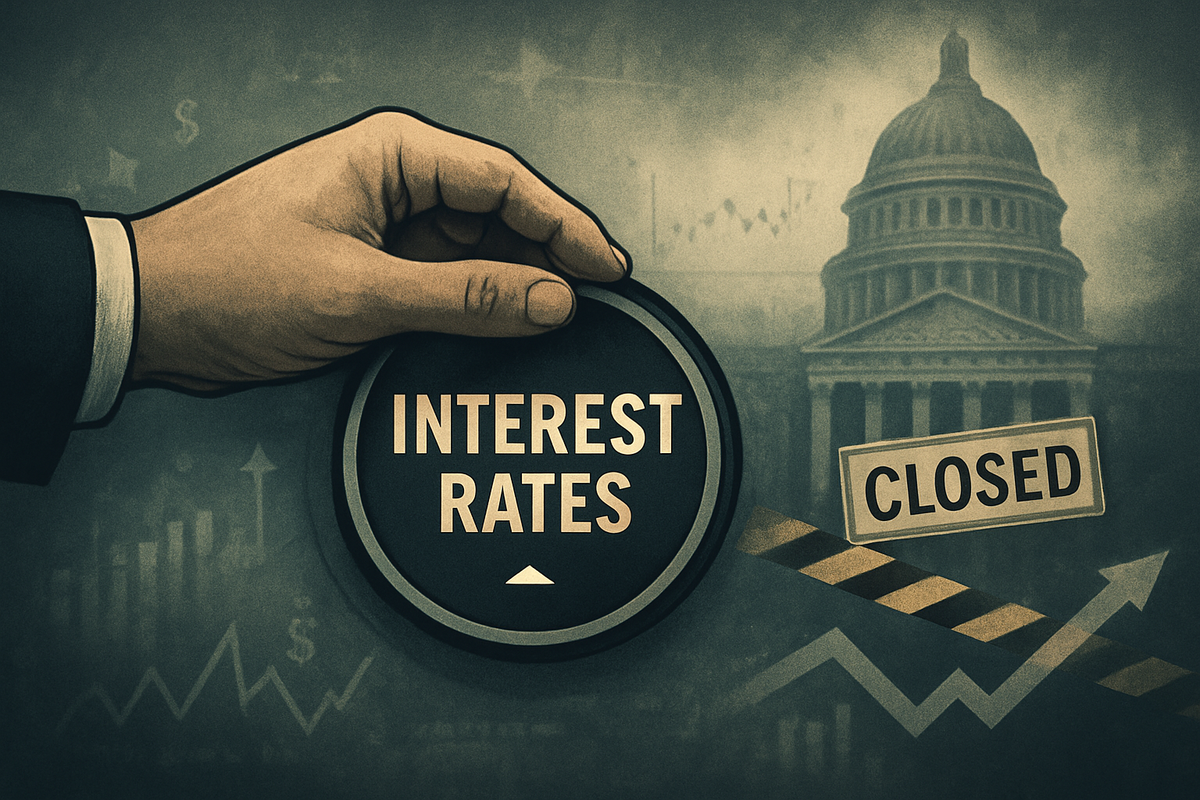Financial News
Federal Reserve Poised for Second Rate Cut Amidst Government Shutdown and Data Drought

Washington D.C., October 27, 2025 – The financial world is holding its breath as the Federal Reserve’s Open Market Committee (FOMC) convenes this week, from October 28-29, to deliberate on its next interest rate decision. All signs point to a highly anticipated second interest rate cut of 25 basis points for 2025, a move largely seen as an "insurance cut" to bolster a softening economy. This critical decision, however, is being made under an unusual cloud of uncertainty: an ongoing U.S. government shutdown that has severely curtailed the availability of crucial economic data, leaving policymakers and investors navigating a "data drought."
The immediate implications of this scenario are multifaceted. A rate cut, while generally welcomed by equity markets and borrowers, will likely lead to lower yields on government bonds and a potentially weaker U.S. Dollar. The absence of comprehensive official economic reports, such as the monthly jobs report and the full Consumer Price Index (CPI), complicates the Fed's assessment of the economic landscape, injecting an additional layer of risk and speculation into market sentiment.
A Second Cut in a Fog of Uncertainty
The Federal Reserve's upcoming decision is widely expected to result in a 25-basis-point reduction in the federal funds rate, lowering the target range to 3.75%-4.00%. This follows a similar cut in September and is heavily telegraphed by market indicators, with the CME Group's FedWatch tool showing a probability exceeding 96% for such a move. Fed Chair Jerome Powell and other FOMC members are balancing their dual mandate of maximum employment and price stability against a backdrop of evolving economic signals.
The primary drivers behind the anticipated cut include a perceived softening in the labor market, with officials noting "shaky" or "somewhat softer" job growth, and moderating, albeit still elevated, inflation. The September 2025 Consumer Price Index (CPI), released on October 24, showed a year-over-year increase of 3.0%, cooler than expected, providing some room for easing. These "insurance cuts" are designed to preempt a more significant economic downturn rather than aggressively stimulating new growth.
However, the ongoing government shutdown, which began on October 1, has created an unprecedented challenge for the Fed. Key federal agencies like the Bureau of Labor Statistics (BLS), Bureau of Economic Analysis (BEA), and Census Bureau have suspended the release of vital economic data. The September jobs report, for instance, was not issued. While Chair Powell has indicated the Fed has access to alternative public and private-sector data, the absence of official, comprehensive reports undeniably complicates their decision-making process and adds to market jitters. Private sector data from organizations like the Institute for Supply Management (ISM) and Automatic Data Processing (ADP) continue to be released, but they cannot fully substitute the breadth and depth of government statistics. This "data drought" makes accurate economic forecasting exceptionally difficult and increases the risk of policy missteps.
Winners and Losers in a Shifting Landscape
The Federal Reserve's interest rate decision, coupled with the economic uncertainty from the government shutdown, will create distinct winners and losers across various sectors of the public market.
Potential Winners:
- Growth Stocks and Technology Companies: Lower interest rates typically reduce borrowing costs, making it cheaper for growth-oriented companies, particularly in the technology sector, to finance expansion and innovation. Companies like Apple (NASDAQ: AAPL), Microsoft (NASDAQ: MSFT), and emerging tech firms could see increased investment and higher valuations as the cost of capital decreases and investors seek higher returns outside of fixed income.
- Real Estate and Construction: Reduced mortgage rates, which have already dipped ahead of the Fed's decision, can stimulate housing demand. This benefits homebuilders like D.R. Horton (NYSE: DHI) and Lennar (NYSE: LEN), as well as real estate investment trusts (REITs) like Prologis (NYSE: PLG), which may see increased property values and rental income.
- Consumer Discretionary Companies: Lower borrowing costs for consumers can translate into more disposable income, potentially boosting sales for retailers and consumer discretionary companies such as Amazon (NASDAQ: AMZN) and Starbucks (NYSE: SBUX), assuming consumer confidence is not severely eroded by the government shutdown's broader economic impact.
- Companies with High Debt Loads: Businesses carrying significant debt, particularly those with variable-rate loans, will benefit from lower interest payments, improving their profitability and cash flow. This could include certain utility companies or industrial firms.
Potential Losers:
- Banks and Financial Institutions: While a rate cut can stimulate lending, it often compresses net interest margins (NIMs) for banks like JPMorgan Chase (NYSE: JPM) and Bank of America (NYSE: BAC), reducing the profitability of their core lending activities. The uncertainty from the government shutdown could also lead to reduced loan demand and increased credit risk.
- Insurance Companies: Insurers often invest heavily in fixed-income securities. Lower interest rates reduce the returns on these investments, impacting their profitability and ability to meet future liabilities.
- Companies with Strong Cash Positions and Savers: Businesses that hold large amounts of cash or cash equivalents will earn less interest on those holdings. Similarly, individual savers and retirees relying on income from high-yield savings accounts and Certificates of Deposit (CDs) will see their returns diminish.
- U.S. Dollar-Dependent Importers: A weaker U.S. Dollar, a typical consequence of lower interest rates, makes imports more expensive, potentially impacting companies that rely heavily on imported goods for their supply chains or finished products.
The duration and impact of the government shutdown will also play a critical role. A prolonged shutdown could dampen overall economic activity, leading to reduced consumer spending and business investment across the board, affecting even those sectors that might otherwise benefit from lower rates.
Broader Significance and Historical Parallels
The Federal Reserve's current predicament—navigating monetary policy amidst a government shutdown and a "data drought"—underscores several broader industry trends and carries significant historical weight. This scenario highlights the increasing interconnectedness of fiscal and monetary policy, where political impasses can directly impede the central bank's ability to execute its mandate effectively.
The "insurance cut" strategy itself is a well-worn tool in the Fed's arsenal, often deployed to extend economic expansions or prevent downturns. Historical precedents, such as the Fed's rate cuts in the mid-1990s or the pre-financial crisis period, demonstrate attempts to fine-tune the economy. However, the current environment is distinct due to the simultaneous government shutdown. While previous shutdowns have occurred, their timing relative to a critical Fed meeting and a widely anticipated rate cut, coupled with a significant data void, makes this event particularly challenging. The regulatory implications are profound; the lack of official data makes it harder for regulatory bodies to assess financial health, potentially leading to increased market volatility and reduced transparency. The ripple effects could extend to international markets, as global investors reassess their exposure to U.S. assets in light of heightened uncertainty and a potentially weakening dollar.
The Path Ahead: Navigating Uncertainty
Looking ahead, the short-term outlook is dominated by the immediate aftermath of the Fed's decision and the duration of the government shutdown. If the Fed cuts rates as expected, markets may initially react positively, especially equities. However, sustained gains will depend on the economic data that eventually emerges and the resolution of the shutdown. Should the shutdown persist, the cumulative impact on GDP, estimated at 0.1-0.2 percentage points per week, could lead to a more significant economic slowdown than currently anticipated, potentially necessitating further Fed action.
In the long term, companies will need to adapt strategically. Those reliant on government contracts or permits may face continued operational disruptions. Businesses with international exposure might find opportunities in a weaker dollar, making their exports more competitive. Investors should prepare for continued volatility and a renewed focus on private-sector economic indicators until government data resumes. Potential scenarios range from a quick resolution of the shutdown, allowing the economy to regain footing with the help of lower rates, to a prolonged impasse that could trigger a more substantial economic contraction, forcing the Fed to consider more aggressive easing measures.
A Market in Flux: Key Takeaways
The Federal Reserve's upcoming interest rate decision, made under the shadow of a government shutdown, marks a pivotal moment for financial markets. The widespread expectation of a 25-basis-point rate cut reflects the Fed's proactive stance to support a softening economy, but the accompanying "data drought" introduces an unprecedented level of uncertainty. Key takeaways include the likelihood of lower borrowing costs for consumers and businesses, a potential boost for growth-oriented sectors, and a likely squeeze on bank profitability and saver returns.
Moving forward, investors should closely monitor the resolution of the government shutdown and its impact on the resumption of economic data releases. The market's ability to absorb and interpret this information will be crucial. Furthermore, attention will turn to the Fed's forward guidance in subsequent meetings, as policymakers attempt to recalibrate their strategy in a post-shutdown environment. The lasting impact of this period will be a testament to the resilience of the U.S. economy and the adaptability of its financial institutions, but it also serves as a stark reminder of how political events can directly influence monetary policy and market stability.
This content is intended for informational purposes only and is not financial advice
More News
View More




Recent Quotes
View More
Quotes delayed at least 20 minutes.
By accessing this page, you agree to the Privacy Policy and Terms Of Service.



